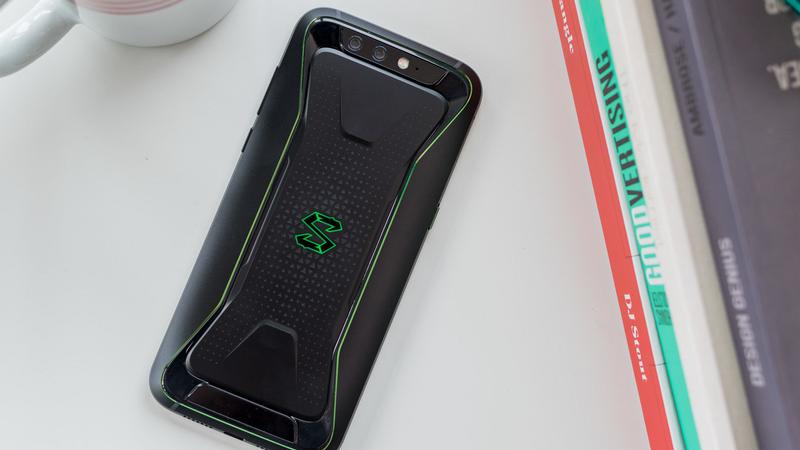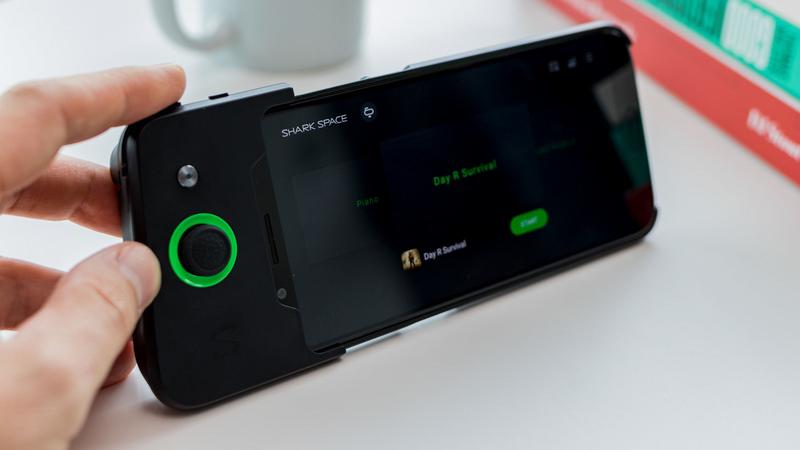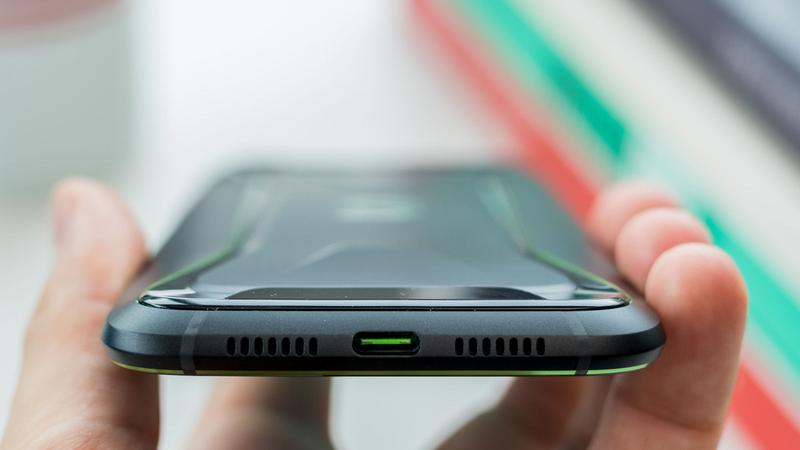The Xiaomi Black Shark is the cheapest of the gaming-focused smartphone range but offers unique features that make it worth considering, including a bespoke game controller that boasts universal Android game support. We’ve spent some time gaming on the Black Shark, courtesy of GearBest, and here we present our full Xiaomi Black Shark review. If you decide it’s not for you, why not take a look at our roundup of the best smartphones to see what else is on the market. Also see: Best Xiaomi Deals
Xiaomi Black Shark: Pricing and availability
The Xiaomi Black Shark is now available to buy after an April 2018 reveal. The catch? It’s not officially available in the UK right now, which means you’ll have to import it from China. The easiest way to do that is to buy the Xiaomi Black Shark from GearBest, which is offering the phone and shipping for £539.78/$692.91. The good news is that the Xiaomi Black Shark is due to officially be available in the UK from 16 November, although official pricing is yet to be confirmed. Though it may seem expensive, the Black Shark is actually one of the cheapest gaming-focused smartphones on the market. The Razer Phone retails at £699, while the upcoming Asus ROG Phone is rumoured to go on sale for around £1000.
Xiaomi Black Shark: Design and build
While many smartphones in the market in 2018 look broadly similar, the Xiaomi Black Shark’s gaming-inspired design makes it stand out from the crowd, and it’s clear who the phone is aimed at.
The rear of the smartphone isn’t a single sheet of aluminium or glass, oh no; it’s layered and textured, mimicking the look of high-end gaming laptops. That’s enhanced by (admittedly Razer-esque) lime-green accents found across the rear and along the bezels at the front of the display, adding a much-needed splash of colour to an otherwise single-colour smartphone. And, in true gaming laptop fashion, the Black Shark logo on the rear lights up whenever the phone is being charged, and whenever the dedicated game mode is activated. The game mode, dubbed Shark Mode after the smartphone, is activated by a physical switch located on the side. We’ll go into the specifics of Shark Mode below, but we think that the inclusion of a physical switch rather than a dedicated gaming app is a great move. While apps can disappear into obscurity, having an easy-access switch at hand means it’s more likely to be used by gamers. It has certainly been the case with us, anyway!
Gaming laptops are generally bigger and bulkier than their non-gaming counterparts, and it’s the same with the Black Shark. It’s fairly bulky, measuring in at 161.6 x 75.4 x 9.3 mm and weighing in at 190g, even when compared to other gaming-focused smartphones like the 8mm-thick Razer Phone. It doesn’t feel particularly bulky in the hand though, thanks to the use of curved edges that fit nicely in the palm of your hands. Though it’s not a bezel-less display like what’s on offer from the likes of the iPhone XS, the Black Shark does sport thin bezels on the side that help it stay slim while sporting a large display. There is a forehead and chin above and below the display, but this is fairly common for gaming-focused smartphones. The black-and-lime combination does look good, but you can also pick the Xiaomi Black Shark up in Gray or Royal Blue, though the latter is exclusive to the 128GB model. What separates the Xiaomi Black Shark from other gaming-focused smartphones is the inclusion of a bespoke controller that turns it into a Switch-esque device. The controller snaps onto the top of the smartphone and connects via Bluetooth, offering two configurable trigger buttons along with an analogue stick for movement when playing mobile games.
Though it doesn’t provide a pair of controllers to attach to either end of the smartphone, using only one can still make a huge difference to mobile gameplay, especially with PvP games like PUBG Mobile and Fortnite. You can map the triggers to look down sights and fire, and these can be remapped on a per-game basis. It’s charged via USB-C, like the Black Shark itself, and offers impressive battery life. Admittedly the layout isn’t perfect (we’d like something slightly bigger) but even in its current state, it really does make a huge difference when playing mobile games, offering something closer to console-level gameplay than mobile.
Xiaomi Black Shark: Features and spec
Beyond the unique look, what does the Xiaomi Black Shark have to offer? With a focus on gaming, the smartphone sports powerful internals alongside a decent display, but it isn’t perfect.
Screen
Let’s start off with the display; the Xiaomi Black Shark sports a 5.99in IPS LCD display with an 18:9 aspect ratio that helps increase the size of the screen without having too much of an effect on the overall width of the smartphone. It’s high-res too, featuring an FHD+ (1080 x 2160) resolution and a pixel density of 403ppi, helping the smartphone to offer crisp, vibrant visuals when playing the latest mobile games or scrolling through Twitter. The main difference between the display on offer from the Black Shark and that on offer by the Razer Phone is the refresh rate; while the Black Shark is capped at 60Hz, the Razer Phone can offer double that, at 120Hz. This means that the display can provide a maximum of 120fps in games, and provides a much smoother, clearer experience both when playing games and when using the phone in general. It’s not a deal-breaker for most, but if you’re a hardcore gamer looking for a gaming laptop-esque experience on mobile, the lack of an enhanced refresh rate may disappoint.
Processor, memory and storage
Beneath the surface, the Xiaomi Black Shark features an octa-core Qualcomm Snapdragon 845 processor, comprised of 4×2.8 GHz Kryo 385 Gold cores, along with 4×1.8 GHz Kryo 385 Silver cores. That’s coupled with the high-end Adreno 630 GPU which is more powerful than the Adreno 540 featured in the Razer Phone, though the amount of RAM depends on the storage option you go for. You’ve got the choice of 6GB, which comes with 64GB of storage, or 8GB of RAM with 128GB of storage. The decision is more important than with other Android phones as, surprisingly, the Black Shark doesn’t feature a microSD card slot to expand storage, so you’re stuck with what you buy! We’ve reviewed and benchmarked the 6GB/64GB variant, so be sure to take this into consideration when taking a look at our benchmark results below. What does this mean, in terms of real-life use? Essentially, the performance is snappy and the Black Shark can easily handle the latest games like PUBG Mobile and Fortnite running on the highest graphics settings with no hint of lag. That high-level of performance isn’t unique to games either; it’s system-wide, with everything from taking snaps on the camera to browsing on Google Chrome being almost-instant. The Black Shark sports a dedicated ‘Shark Mode’ that offers a console-esque experience, allowing you to browse through your collection of Android games via a custom interface, along with blocking any incoming calls and notifications and freeing up RAM.
We thought that clearing the RAM may improve performance, but it didn’t seem to be the case – according to our benchmark results anyway. We ran GFXBench tests both in standard and Shark mode, and got identical results from each. We’ve included full benchmark results below, along with comparisons to other smartphones. The headline results are that it scored 7173 in Geekbench 4, and managed to get up to 31fps on GFXBench Car Chase, the high-level GPU benchmark. Though not quite enough to fight off some high-end smartphones, the discounted price compared to the Galaxy Note 9 and iPhone XS balances it out. It’s certainly good enough for mobile gaming, that’s for sure!
Connectivity and biometrics
The Xiaomi Black Shark is the latest in a long line of high-end smartphones to ditch the headphone jack, though much like Apple, the manufacturer includes a USB-C-to-3.5mm adapter in the box. It’s not the perfect solution as using an adaptor means that you won’t be able to charge and use wired headphones at the same time, but with more and more people investing in wireless headphones, we can’t imagine this will be an issue for much longer.
You’ll also find a fingerprint scanner embedded in the Home button, which works as well as to be expected. It can easily recognise fingerprints from awkward angles, and is lightning-fast at unlocking. The Black Shark also sports Dual-SIM support; a feature that has been popular in Chinese markets for years, and is slowly making its way to the Western market in 2018. Like most smartphones, it’s dual stand-by rather than dual-active, but is still a desirable option for those that travel abroad, or those that use multiple smartphones in everyday life. And, of course, the Black Shark features the latest in connectivity options, including Bluetooth 5.0, Wi-Fi 802.11 a/b/g/n/ac, GPS and a USB-C port for charging.
Cameras
Despite the focus on gaming, the Xiaomi Black Shark features a decent camera setup that is capable of snapping impressive photos, though we do feel that it isn’t quite as strong on the video front. Let us explain. On the rear of the smartphone is a dual-camera setup, comprised of 12- and 20Mp sensors. Both sensors feature f1.8 aperture, and you’ll find a dual-tone flash embedded ready to illuminate dark environments. The use of a dual-camera setup allows for some advanced functionality; alongside the Portrait mode that adds a bokeh effect to blur the background of the photo, the 20Mp sensor offers 2x optical zoom, much like the iPhone XS. We were especially impressed with the edge detection in the Portrait mode, which tends to have hit-and-miss results depending on the manufacturer.
But while the images look vibrant and detailed on the surface, zooming in to 100 percent reveals over-aggressive noise cancellation at play. The details on the bricks of St. Pancras in the below image are soft when zoomed in, making it near-on impossible to make out individual bricks or paving slabs on the pavement. It’s not a huge issue – it’s something that most smartphones fall victim to – but it’s certainly worth highlighting.
It’s rare to see a front-facing camera that can compete with the rear camera, but that’s what we’ve found with the 20Mp front-facing snapper of the Black Shark. The pictures taken are generally in-line with those captured by the rear-facing camera, and despite featuring a single sensor, the Portrait mode is available and nails the edge recognition. It’s more than enough for selfie-taking, Skyping and Snapchatting, and even features a handy Straighten tool to keep your selfies straight.
In terms of video, the Xiaomi Black Shark can record video in 4K, 1080p and 720p, though the latter two options are capped to 30fps. According to Xiaomi, you can record up to 120fps at 720p, but we couldn’t find the option to enable it after exploring the Camera app. The performance wasn’t amazing either; the phone struggles to adjust between different levels of brightness, often leaving highlights blown out if stepping into direct sunlight from shade. There’s no OIS or even EIS on offer either, resulting in fairly shaky videos. It’s a similar story with the front-facing camera; it can record at 1080p@30fps, but the quality can vary greatly depending on the levels of light, and how shaky your hand is when recording. Essentially, it’s handy for capturing little videos to share on social media, but those looking for professional-looking video capture should look elsewhere.
Battery life
With a focus on gaming, the Xiaomi Black Shark offers a whopping 4,000mAh battery to keep you going through those intense mobile gaming sessions. We’ve found that, in reality, the battery life is impressive and is more than enough to last a day with average usage. Even when gaming, we were surprised at how slowly the battery was depleting, though this will vary somewhat on the game that you’re playing, the brightness of the display and more.
When the battery does eventually get low, the Black Shark offers quick charging capabilities, allowing you to quickly charge the smartphone and get back into the action. The only catch is, like with most fast chargers, it’s only compatible with the provided charger. The issue is that the smartphone doesn’t come with a UK-compatible plug, so you’ll have to pick up an adaptor to make the most of the quick charging capabilities.
Xiaomi Black Shark: Software and apps
The Xiaomi Black Shark runs Android 8.1 Oreo, and while it’s not stock Android, it’s as close as it could get. It runs Xiaomi’s JoyUI, but it’s not heavy on custom elements like other Android skins. We even put it side-by-side with an Android One device and could barely tell the difference! There aren’t any pre-installed apps beyond the Google suite of apps, all of which can be removed if not useful. It’s worth pointing out that despite the similarities, it isn’t actually Android One-supported, so it won’t get the monthly security updates from Google like supported devices will.
The most interesting feature of the Black Shark’s software is the Shark Mode, Xiaomi’s console-esque dedicated game mode activated by flipping the physical switch on the side of the smartphone. Shark Mode will display all installed Android games in one simple-to-access place while also blocking any incoming calls and notifications for interruption-free gameplay. It also clears the RAM on the smartphone for enhanced performance, though as mentioned above, we didn’t really notice any difference in terms of performance from our benchmarks. The best part of Shark Mode is that it allows you to customise the controller support on a per-app basis. You can access the controller settings at any point in-game, and using an on-screen overlay, you can adjust the function of each button. This means that you’re able to use the controller on games that don’t officially support controllers, including Fortnite and PUBG Mobile, really helping to give you the edge in online gameplay.
Related stories for further reading
Best phone deals Best SIM-only deals Best phone network All smartphone reviews Best smartphones How we test smartphones Best new phones coming soon
Lewis Painter is a Senior Staff Writer at Tech Advisor. Our resident Apple expert, Lewis covers everything from iPhone to AirPods, plus a range of smartphones, tablets, laptops and gaming hardware. You’ll also find him on the Tech Advisor YouTube channel.










